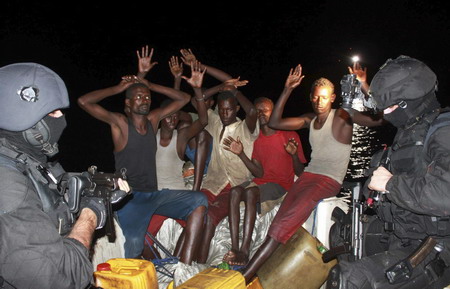Somali pirates hijack $20M of oil going to US
|
 Portuguese Navy Frigate NRP "Alvares Cabral" special forces marines capture a pirate group that attacked the Spanish flagged fishing vessel "Ortube Berria" in the Indian Ocean in this NATO handout photo made available November 30, 2009. [Agencies] |
NAIROBI, Kenya: Crews on oil tankers aren't allowed to smoke above deck, much less carry guns, for fear of igniting the ship's payload. That's one of the main reasons Somali pirates met little resistance when they hijacked a US-bound supertanker carrying $20 million in crude.
The Greek-flagged tanker, traveling from Saudi Arabia to New Orleans, had no escort when it was hijacked Sunday because naval warships are stretched too thin. The problem has been further exacerbated because pirates have expanded their operations to hundreds of miles out at sea.
The Maran Centaurus was about 800 miles (1300 kilometers) off the coast of Somalia when it was hijacked with 28 crew, said Cmdr. John Harbour, a spokesman for the EU Naval Force. On Monday, it was headed toward Somalia's lawless coast, a location where pirates most likely will hold the vessel as they attempt to negotiate a multimillion-dollar ransom.
While some ships traveling in the region have been outfitted with high pressure water guns and piercing noisemakers to repel pirates, even this is shunned on oil tankers for fear of triggering a response from pirates armed with guns and rocket-propelled grenades.
"If you're not allowed to smoke a cigarette on the upper deck of an oil tanker, why would you want someone with a weapon up there?" said Graeme Gibbon-Brooks, who heads the private security company Dryad Maritime Intelligence.
There is also the threat that an accident or gunfight could lead to a leak that would devastate thousands of miles of ocean or coastline.
Protecting the huge tankers that carry more than half of the world's oil supply is made even more difficult because of their slow speed.
Sailors can typically distinguish fishermen from pirates around 300 yards, but by then it is too late to stop most attacks, said Gibbon-Brooks.
Expense and legal worries rule out armed escorts on a separate ship, he said, suggesting the best way to evade attack was for tankers to increase speed and steer the ship 30 to 45 degrees either side of its course. The swinging motion increases wake, destabilizing pirate skiffs, and keeps the low stern moving where pirates usually board. Trailing nets or lines behind vessels can also help by fouling the propellers of pirate skiffs, he said.
The Maran Centaurus was traveling about 11 knots when it was hijacked, according to Maj. Marten Granberg of the EU Naval Force. Most successful hijacks occur on ships traveling less than 20 knots. The ship was heading toward New Orleans, he said.
Gibbon-Brooks said he had recently received information from contacts in Somalia that more attacks were planned on tankers.


























